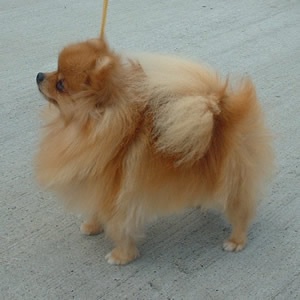
The Pomeranian (often known as a Pom) is a breed of dog of the Spitz type, named for the Pomerania region in Central Europe (today part of eastern Germany and northern Poland). Classed as a toy dog breed because of its small size, the Pomeranian is descended from the larger Spitz type dogs, specifically the German Spitz. It has been determined by the Fédération Cynologique Internationale to be part of the German Spitz breed, and in many countries, they are known as the Zwergspitz (Dwarf Spitz), or Toy German Spitz.
The breed was made popular by a number of royal owners during the 17th and 18th centuries. Queen Victoria owned a particularly small Pomeranian at the time, and consequently the smaller variety become universally popular. During Queen Victoria’s lifetime alone, the size of the breed decreased by 50%. Pomeranians respond well to firm, consistent obedience training, but otherwise will do what they please. They are known to bark defensively in response to any outside noise. Overall the Pomeranian is a sturdy, healthy dog. Luxating patellas is the most common health issue, although there is also another condition unique to the breed sometimes called black skin disease. The breed is currently among the top 15 most popular in the USA, and the current fashion for small dogs has increased their popularity worldwide.
Appearance
Pomeranians are small dogs weighing 1.8–3.5 kilograms (4.0–7.7 lb) and standing 5.0–11 inches (13–28 cm) high at the withers. They are compact but sturdy dogs with an abundant textured coat with a highly plumed tail set high and flat. The top coat forms a ruff of hair on the neck and back, and they also have a fringe of feathery hair on the hindquarters.
The earliest Poms were white or occasionally black, however Queen Victoria adopted a small red Pomeranian in 1888, which caused that colour to become fashionable by the end of the 19th century. In modern times, the Pomeranian comes in the widest variety of colours of any dog breed, including white, black, brown, red, orange, cream, blue, sable, black and tan, brown and tan, spotted, brindle, plus combinations of those colours. The most common colours are orange, black or cream/white.
The merle Pomeranian is a recent colour developed by breeders. It is a combination of a solid base colour with lighter blue/grey patch which gives a mottled effect. The most common base colours for the effect are red/brown or black, although it can also appear with other colours. Combinations such as brindle merle or liver merle are not accepted in the breed standard. In addition, the eye, nose and paw pad colours are different in merles, changing parts of the eye to blue and the colour on the nose and paw pads to become mottled pink and black.
Pomeranians have a thick double coat, and while grooming is not difficult, breeders recommend that it is done daily because of the thickness of the coat and the constant shedding. The coat knots and tangles easily, particularly when the undercoat is being shed, which happens twice a year.
Behaviour
Pomeranians are typically very friendly and lively. This breed of dog loves to be around their owners and can be protective of them. They bond quickly with their owners, and can suffer from separation anxiety if not trained to spend time alone. Pomeranians are alert and aware of changes in their environment and barking at new stimuli can develop into the habit of barking excessively in any situation. They are somewhat defensive of their territory and will bark at any outside noise. Pomeranians are intelligent dogs and can be very successful in getting what they want from their owners. Their intelligence, however, means that they respond well to training.
They tend to seek out cooler environments, and it is common to find one lying down on a cold floor. The breed is good for apartment living, and are very active indoors.
—————————————————————————————————————–
CARING FOR YOUR DOG NEWSLETTER – Delivered Directly To Your Inbox – Starting Immediately – SIGN UP FOR FREE TODAY
—————————————————————————————————————–
